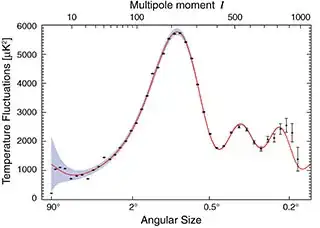Especially one of the authors is famous but the research of these CMB circles produced before the Big Bang resembles the research of crop circles produced by extraterrestrial aliens. In reality, the actual number of such "strong enough circles" is exactly what the statistical predictions based on standard cosmological models predict. It has to be so.
The authors have posted several papers with almost the same content and they're slightly changing the message. For example, in the newest paper you mentioned, they try to place their "new effects" in the large-$L$ region (low angular separation or apparent radii of the circles).
However, the fundamental flawed content remains unchanged. It's a simple mathematical fact that the excess of arbitrary spherically symmetric "special patterns" that can be described by a quadratic score
$$\int d \theta_1 d\phi_1\, d\theta_2 d\phi_2 K(\theta_1,\phi_1,\theta_2,\phi_2) \Delta T(\theta_1,\phi_1)\Delta T(\theta_2,\phi_2)$$
and the Penrose-Gurzadyan "concentric circles" surely belong to this category (they haven't studied any non-Gaussianities, and even if they had, none of them are detectable in the measured WMAP spectrum as of today, anyway) - is inevitably included in the power spectrum as a function of $L$. For a simple proof, see
http://motls.blogspot.com/2010/12/why-penrose-and-gurzadyan-cannot-see.html
The kernel of their quadratic score $K(\hat n_1,\hat n_2)$ may be expressed as an operator acting on functions of $S^2$, the celestial two-sphere, and if this operator (e.g. if their rule to detect circles) is spherically symmetric, it has to be a function of $L^2$ only which means that this whole operator may be fully described by the eigenvalues it has when acting on $L^2$ eigenstates. In other words, it is fully encoded in the WMAP spectrum as a function of $L$.

The WMAP spectral curve knows everything about the abundance of arbitrary patterns as long as this abundance may be described by a spherically symmetric score that is bilinear in $\Delta T$.
So one doesn't have to look at the particular data to be sure that the authors are misleading themselves. What they write about the excess, relatively to the predictions of the famous WMAP curve included on the picture above, is as impossible as $2+2=5$.
Before I admitted to myself that such famous authors (or one of them) could be ignorant about basic methods linked to the spherical harmonics, I wrote two texts speculating that they rediscovered something that is actually valid. One of them was:
http://motls.blogspot.com/2010/11/what-penrose-and-gurzadyan-have.html
But I no longer think that the article above is relevant. Their methodology is way too rough and unrefined for them to rediscover the things I thought that they rediscovered.
As long as one defines the "score" quantifying the number of concentric circles with various properties in terms of squared temperature differences in various pairs of the skies, this "score" is fully included in the WMAP spectrum that depends on $L$, and because this spectrum beautifully agrees with the predictions of the LCDM standard cosmological model, there's no room for some "improvements".
Independently of this basic mistake, I am surprised how incredibly superficial analysis they want to be making. They just want to answer the question "too many concentric circles Yes/No", and moreover, they give a wrong "Yes" answer to this question (by cherry-picking and irrationally overemphasizing some vaguely defined circles they like, without doing a proper statistical scrutiny of well-defined properties of the WMAP maps). Meanwhile, proper cosmology is predicting and testing whole detailed functions of $L$ with many bumps etc. - something that they're extremely far from addressing. The idea that they could compete with the standard cosmological model, without saying iota of valid things about the WMAP spectral curve, is preposterous.
Also, the mechanism of the proposed cyclic cosmology couldn't work to produce the alleged patterns. Incredibly enough, the main mistake that Penrose et al. do is a wrong Penrose diagram (note that the same name appears twice) for a Big Bang Cosmology. There can't be any "non-inflating" cosmology that has this big volume "before the Big Bang". If one wants to extend the diagram in this way, it's inevitable to include some very fast expansion of space that is inflation - at least when it comes to its consequences for the spacetime geometry. One should then ask what this inflation-like evolution of the geometry was caused by. And all known legitimate solutions are "morally" versions of inflation; it has to be so. I discussed these matters here:
http://motls.blogspot.com/2010/11/penroses-ccc-cosmology-is-either.html
So in my opinion, the authors have to get a failing grade in modern cosmology. Moreover, I am somewhat afraid that especially Penrose has to have understood the spherical harmonics calculus by now and he's defending the indefensible partly in order to promote a popular book he no longer wants to scratch (even though an honest scientist definitely should) - and this book is based on similarly incorrect statements.
